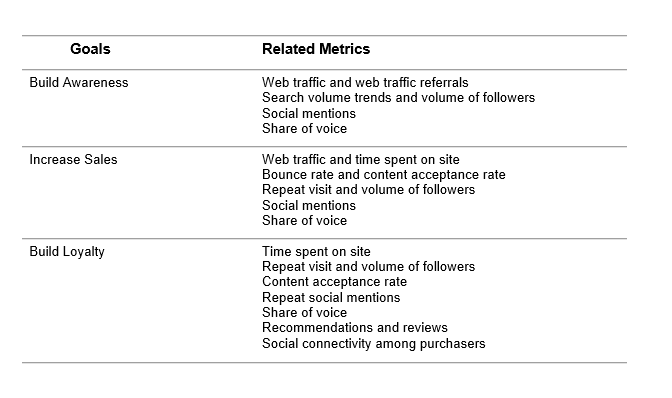Social media refers to online services that support social interactions among social media users through highly accessible and scalable web-based publishing techniques (Dutta, 2010), in order to co-create, find, share and evaluate the online information repository

According to Castronovo and Huang (2012), social media can be used to accomplish one of three goals for a business: building awareness, increasing sales, or building loyalty. If the goal is to build awareness, measurement of success will revolve around the analysis of web traffic, web traffic referrals, volume of followers, social mentions, and share of voice. If the goal is to increase sales, measurement of the social media program’s success must take into account web traffic, time spent on the site, repeat visits, content acceptance rate, followers, social mentions, and share of voice. If the goal is to build loyalty, success measurement will need to include an analysis of time spent on the site, repeat visits, followers, content acceptance rate, repeated social mentions, share of voice, recommendations and reviews, and social connectivity among purchasers.
by
Nantia Tigani &
Antonis Zairis
Social media
Kaplan and Haenlein, (2010) define social media as a group of internet-based applications that build on the ideological and technological foundations of Web 2.0, and the internet-based applications allow the exchange of user-generated content (Lee, 2014). Safko and Brake (2009), refer to media that people can use to be social. In the end, social media are about online interactions and connections (Looy, 2016).
Social media regarded as a medium of marketing by many businesses. Social media have changed the ways in which businesses communicate with their customers and vice-versa. It allows businesses to customize messages and make them interactive by involving the user in the construction of the message. As noted by Oracle (2012) and Salermo et al., (2013), consumers are helping business shape their brand and service by having conversations with other consumers that will ultimately affect the revenue of the businesses. Moreover, according to Trusov, Bucklin and Pauwels (2009), word-of-mouth on internet social networking site has a strong impact on new customer acquisition and has longer carryover than traditional forms of marketing.
Social media and internet have proven to be the most powerful tools in directing the mindsets of customers. There is a large number of social media that SMEs can use to interact with their customers. The most popular social media platforms are Facebook, Twitter, LinkedIn, YouTube and Blogging ( Peres and Mesquita, 2015).
Social media tools can provide improved communication and collaboration between the firm and its stakeholders (e.g. customers, suppliers, business partners) (Burke, Fields and Kafai, 2010, Culnan, McHugh and Zubillaga, 2010), an innovative way for firms to identify products with high selling potential (Liang and Turban, 2011) and a better channel for attracting and retaining online customers (Information Resources Management Association, 2016). According to Coremetrics (2010), social media is the fastest-growing marketing channel in the world, (Pentina, Koh and Le, 2012).
Social media tools and their objectives. Source: Castronovo & Huang, 2012

Measurements of success of Social Media
According to Castronovo and Huang (2012), social media can be used to accomplish one of three goals for a business: building awareness, increasing sales, or building loyalty. If the goal is to build awareness, measurement of success will revolve around the analysis of web traffic, web traffic referrals, volume of followers, social mentions, and share of voice. If the goal is to increase sales, measurement of the social media program’s success must take into account web traffic, time spent on the site, repeat visits, content acceptance rate, followers, social mentions, and share of voice. If the goal is to build loyalty, success measurement will need to include an analysis of time spent on the site, repeat visits, followers, content acceptance rate, repeated social mentions, share of voice, recommendations and reviews, and social connectivity among purchasers. Therefore, the most appropriate success measurement techniques depend on the specific goal that is being pursued through the social media marketing program (Baer, 2009).
The table below shows the social media strategy goals and their related metrics:

Social Media Strategy Goals and Related Metrics
As traditional marketing and sales methods no longer work because the traditional methods are less effective, companies should incorporate into their strategy the social media whose use offer significant benefits to the competitive advantage and increase of profitability (KPMG, 2011, p.2). According to Statista (2017), in 2015, worldwide revenue from social media came to a total of 22.9 billion euros.
SMEs have to introduce new technologies to enter into global markets and find ways to attract customers if they want to compete in global scenarios. As larger organizations are entering into Internet-enabled business, SMEs have to upgrade their tools and techniques to equip themselves with the abilities to compete with large organizations. In addition, more has to be done to encourage stability and growth in the SME business sector, and to establish globally competitive firms. SMEs face the challenges of fast-changing technology and business scenarios in the knowledge-based economy (Al-Qirim, 2004).
SMEs who engage in social media sites and product/service specific blogs have in some cases shown a tremendous ability to engage with customers and ultimately drive sales (Brychan and Geoff 2010, p. 131). According to Neti (2011), social media gives businesses on small budgets the ability to find out what people are saying about them in their industry, without paying large sums on market research. With its ear to the ground on social media, the company will be the first to know if its product is working or if changes need to be made. The following table sums up the most common social media tools and their objectives.
Benefits of Social Media for SMEs
According to Kaplan & Haenlein (2010), the benefits of social media are currently a topic of great discussion in the business press. The use of social media applications has extended beyond individuals to attract the interest of businesses (Stockdale, Ahmed and Scheepers, 2012). According to Meske and Stieglitz (2013), social media becomes increasingly relevant for small and medium-sized enterprises (SMEs).
There are number of opportunities for gaining competitive advantage that can be realised by SMEs using social media, including improved communication with customers (Meske and Stieglitz, 2013, Schaffer, 2013), better interaction with suppliers (Michaelidou, Siamagka and Christodoulides, 2011), brand and reputation enhancement (He, Wang and Zha, 2014), market research (Kim, Lee and Lee, 2011) and knowledge sharing (Peres and Mesquita, 2015).
Small enterprises can interact with their stakeholders and can receive opinions/suggestions to improve their products/services. Social media open a wide range of opportunities for small firms, because they are cheap and don’t require high-level technological competences. Micro and small enterprises, which are usually deep-rooted in their local environment, may take advantage of Web 2.0. (Cesaroni and Consoli, 2015).
According to Stockdale, Ahmed and Scheepers (2012), smaller businesses can gain business value from the use of social media for internal and external purposes (Geho, Smith & Lewis 2010). The ease of use and ‘elementary directions’ of the different applications make social media accessible to both inexperienced and technically orientated people (Lacho & Marinello 2010, p.128). This accessibility is of particular relevance to small and medium sized enterprises (SMEs) that have traditionally lacked the skills to effectively use IT, but who benefit from the technology when they use it well (Wielicki & Arendt, 2010).
*Nantia Tigani is Marketing and Public Relations Professional. Antonis Zairis is Vice President of Hellenic Retail Business Association.






 By: N. Peter Kramer
By: N. Peter Kramer
